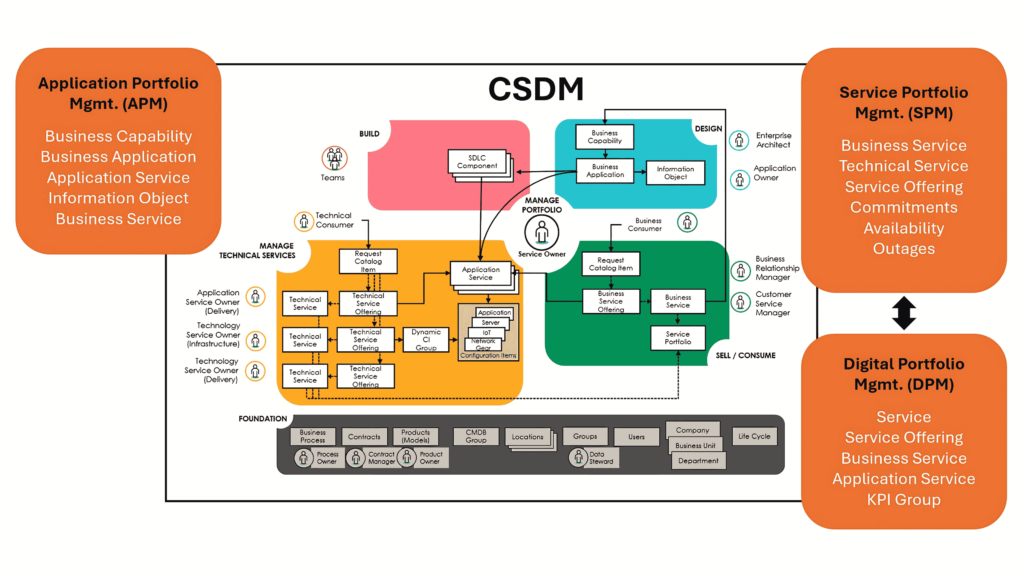How CSDM Connects IT Operations to Business Strategy
In today’s fast-paced digital world, organizations face increasing pressure to align IT operations with business outcomes while reducing costs and improving efficiency. The Common Service Data Model (CSDM), a foundational ServiceNow framework, provides a solution to this challenge.
CSDM is more than just a CMDB enhancement—it’s a service modeling framework built on the CMDB and related asset data. It underpins not only Configuration Management and Asset Management but also plays a critical role in enabling Application Portfolio Management (APM), Strategic Portfolio Management (SPM), Technology Portfolio Management (TPM), and Digital Portfolio Management (DPM). By adopting CSDM, life sciences organizations have streamlined their operations, ensured compliance, and generated measurable ROI.
What is CSDM and Why Does It Matter?
CSDM provides a standardized framework for defining and managing the relationships between IT services, business applications, and infrastructure. It ensures accurate and consistent data modeling and allows seamless integration across the ServiceNow platform.
Key benefits include:
- Standardized Data Structure: Ensures consistency across ServiceNow modules like ITSM, ITOM, ITBM, and SecOps.
- Platform-Wide Visibility: Enables cross-functional alignment by supporting APM, SPM, TPM, and DPM.
- Improved Incident and Change Management: Clearly identifies impacted components and supports effective response.
- Enhanced Compliance: Strengthens audit readiness through structured data and governance.
- Foundation for ITOM Automation: Supports downstream workflows and dependency mapping across business-critical services.
Note on GxP: While CSDM is not specifically tailored for GxP compliance, its structured, standardized approach improves governance and traceability, making it a valuable tool for regulated environments. Life sciences organizations have applied CSDM in ways that support GxP-aligned operational processes.
ROI Benefits of CSDM Implementation
Implementing CSDM yields both quantitative and qualitative benefits that drive business value:
- Operational Efficiencies: Automation reduces manual effort, accelerating processes and cutting costs. Organizations often see a 30% reduction in mean time to resolution (MTTR).
- Improved Service Delivery: Aligning IT services with business processes enhances uptime critical systems, minimizing financial and reputational losses due to outages.
- Compliance and Risk Reduction: Clear service mapping and data integrity reduce the risk of audit failures and non-compliance.
- Scalability: CSDM facilitates growth by standardizing and simplifying IT operations across business units.
- Strategic Portfolio Integration: CSDM’s relationships enable tighter integration with APM, SPM, and DPM—creating strategic insights at scale.
Key Metrics to Measure ROI with CSDM
Tracking the proper metrics is essential for assessing the success of your CSDM implementation. Focus on:
- Mean Time to Resolution (MTTR): Decrease in incident resolution time.
- Downtime Avoidance: Financial impact of improved uptime.
- Operational Cost Reduction: Cost savings from automated workflows.
- CMDB Data Accuracy: Target 95%+ accuracy to support reliable service modeling.
- User Satisfaction: Gauge improvements using Net Promoter Scores (NPS) or similar metrics.
Visualizing the Relationships: CSDM + APM, SPM, and DPM
The diagram below illustrates how CSDM supports APM, SPM, and DPM. Each layer depends on CSDM’s consistent service definitions to deliver strategic insights, automate workflows, and manage service portfolios effectively.
- APM: Business capabilities, applications, and services are cataloged and analyzed.
- SPM: Tracks service performance, commitments, and availability.
- DPM: Connects service offerings and performance metrics with strategic goals.
Best Practices for Achieving Maximum ROI with CSDM
To fully realize the value of CSDM, consider these strategies:
Align IT Operations with Business Goals
Define how services contribute to business objectives. Build service maps to ensure every technical service is tied to a business capability or outcome.
Automate Processes for Efficiency
Use ServiceNow automation to handle tasks like incident routing, change approvals, and outage notifications. Leverage CSDM to guide rule-based workflows and escalation paths.
Regularly Review Data Accuracy
Audit your CMDB regularly. Identify and eliminate duplications, stale data, or misclassified configuration items (CIs). Poor data quality undermines the benefits of CSDM.
Connecting IT Operations to Business Outcomes
CSDM is not just a data model—it’s a strategic foundation for enabling regulatory compliance, operational efficiency, and digital transformation across the enterprise. USDM’s compliance-first approach accelerates business outcomes by aligning IT services with critical business goals.
Why Executives Should Care
- Improve audit readiness and reduce compliance burden
- Enable automation and reduce mean time to resolution (MTTR)
- Link digital services to business capabilities
- Unlock visibility for strategic decision-making with APM, SPM, and DPM
- Increase uptime and prevent business disruption
ROI Anchors: From IT Metrics to Executive Value
- MTTR Reduction: 30% improvement → Labor cost savings, faster incident closure
- Audit Prep Time: 40-50% reduction → Reduced compliance overhead
- Downtime Avoidance: Protects $MMs in digital revenue
- CMDB Accuracy >95%: Enables automation, reporting, risk control
- NPS & Satisfaction: Improved end-user and stakeholder trust
USDM Differentiators Compliance Readiness:
- Compliance-First Design: GxP-aligned service modeling
- Cloud Assurance for Ongoing Validation
- Strategic Portfolio Integration: APM + SPM + DPM
- Managed Services for Continuous Compliance
- Change Management & Adoption Enablement
Final Thoughts
CSDM is not just a data model—it’s a strategic enabler. Let’s shift the conversation from technical configuration to strategic enablement. CSDM is your foundation. USDM is your accelerator. By standardizing service relationships and aligning them to the broader goals of IT and the business, CSDM empowers organizations to:
- Improve service performance
- Enhance compliance and governance
- Reduce costs
- Unlock new strategic capabilities via APM, SPM, and DPM
When implemented effectively, CSDM serves as the digital backbone of IT transformation.
About the Author
John Zhang has received the esteemed designation of ServiceNow MVP three years in a row. He is one of the few thought leaders on CSDM and recognized as one of the most experienced consultants in the field.








